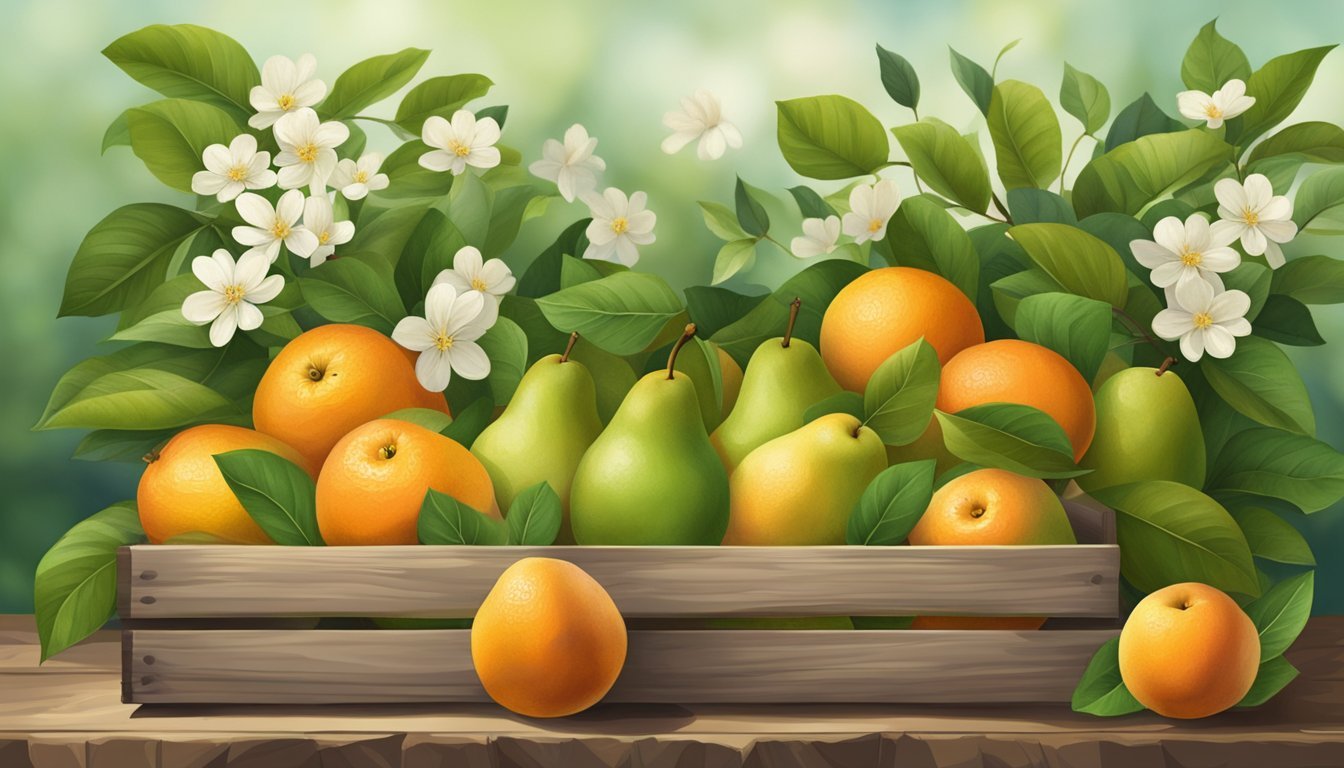Pennsylvania Seasonal Fruit & Vegetables in January
Your Fresh Produce Guide
This Article is Part of our Pennsylvania Seasonal Fruit & Veg Calendar
In the heart of winter, Pennsylvania's landscape is often draped in snow, and the local agriculture feels the impact of the cooler temperatures and shorter days. Despite this, January in Pennsylvania still offers a selection of fresh, seasonal fruits and vegetables. While the fields may not be as bountiful as the summer months, local farmers and indoor growers manage to supply a variety of produce.
Seasonal eating in Pennsylvania during January emphasizes robust root vegetables and hardy greens that can withstand the cold, seemingly at odds with the frigid weather outside. These crops are usually harvested in the late fall and can be stored through the winter months, ensuring that consumers have access to fresh, locally-grown produce. Understanding what is available seasonally can enhance the freshness and flavor of meals while supporting local agriculture and reducing environmental impact from long-distance food transport.
Farmers' markets and local grocery stores highlight these seasonal offerings, giving Pennsylvanians the opportunity to cook with ingredients at their peak of freshness. From the crisp, tangy apples (how long do apples last?) still available from cold storage to the earthy sweetness of winter squashes and root vegetables like turnips and parsnips, there is a surprising variety of fruits and vegetables to be enjoyed during Pennsylvania's winter season.
Understanding Seasonality in Pennsylvania
In Pennsylvania, the concept of seasonality is crucial in agriculture because it affects what crops are available throughout the year. January falls squarely in the winter season when the weather is cold, and the days are shorter. This has a significant impact on the type of crops that can be harvested during this time.
Mostly, the crops available are those that can withstand the winter climate. In January, Pennsylvania fields lie dormant, and fresh produce is limited. However, crops stored from fall, such as apples and root vegetables, remain available.
The following is a list of typical crops you might find in Pennsylvania during January:
Apples (stored from fall)
Potatoes
Onions
Carrots (how long do carrots last?)
Farmers often utilize greenhouses and other means to extend the growing seasons of certain produce beyond what the calendar and local climate might normally allow. However, the authentic seasonal offerings are generally limited to heartier varieties that are well-adapted to the winter conditions.
Pennsylvania's agricultural sector relies heavily on understanding these seasonal patterns to effectively plan the planting and harvesting schedules. As consumers seek fresh and local produce, they become attuned to the seasonal availability dictated by the state's weather patterns and harvest cycles.
Winter Weather and Crop Growth
In Pennsylvania, January's winter weather brings cold temperatures that can dip below freezing. This seasonal climate significantly impacts the types of crops that can grow during this period. Cold-hardy vegetables can tolerate the harsh conditions, while others require protective measures like cold frames or greenhouses to survive.
Temperature plays a crucial role in crop sustainability. Soil tends to freeze when ambient temperatures consistently remain at or below 32°F (0°C). This state can impede root growth and nutrient uptake, challenging plant health.
Vegetables that typically thrive in January's soil conditions are those resilient to Pennsylvania's cold weather. Selected varieties have adapted to shorter daylight hours and the soil's reduced biological activity. Here are common vegetables suited to this season:
Root vegetables: such as carrots and beets, withstand cold with natural insulation.
Leafy greens: including kale (What wine goes well with kale?) and spinach, often prosper despite the chill.
Brassicas: like cabbage and brussels sprouts (how long do brussels sprouts last?), flourish in cooler soils.
Farmers and gardeners might employ growing strategies like mulching to conserve soil warmth and moisture. Additionally, utilizing high tunnels or row covers extends the growing season for more delicate produce.
In summary, Pennsylvania's winter demands a strategic approach to agriculture. January's frost-laden landscapes necessitate selecting robust vegetables and implementing techniques to mitigate the cold's effects. Those who understand and respect the region's frigid weather patterns can successfully cultivate a winter harvest.
Seasonal Fruit Overview for January
January in Pennsylvania is a time when the selection of local fruits (What wine goes well with fruit?) is more limited due to the cold weather conditions. However, consumers can still enjoy a variety of fruits that are in season, boasting robust flavors and optimal ripeness.
Citrus fruits, imported from warmer climates, are abundant and at their peak in January. They offer a burst of sunshine during the chilly month, with oranges and lemons being particularly flavorful and juicy. These citrus products are not just rich in flavor but also high in vitamin C, which is beneficial for immune support during the winter.
For local produce, several fruits that were harvested in the late fall continue to be available and enjoyable in January due to their longer shelf life. Apples and pears, stored properly, maintain their crispness and sweetness, making them a staple in the fruit baskets of Pennsylvania.
Here is a concise list of fruits one can typically find in January in Pennsylvania:
Apples: Retaining their crisp texture and sweetness
Pears: Juicy and subtly flavored, perfect for various culinary uses
Citrus: Including oranges and lemons, vibrant and vitamin-rich
Each fruit brings its distinct flavor profile to the table, and whether consumed fresh or incorporated into warming winter recipes, they provide comfort and nutrition during Pennsylvania’s coldest month.
Seasonal Vegetable Overview for January
In Pennsylvania, January's chilly temperatures and frost-covered fields mark a time for cold-hardy vegetables. Root vegetables and sturdy greens dominate the produce available, each with its distinct flavors and nutritional profiles, ideal for winter meals.
Root Vegetables:
Carrots: Sweet and crunchy, often stored well into winter.
Potatoes: Versatile for a myriad of dishes; stores well.
Turnips: With a slightly peppery taste, suitable for roasts and stews.
Onions: A foundational ingredient for soups and savory dishes.
Sturdy Greens:
Kale: Nutrient-dense and hearty; holds up well in cold weather.
Collards: Similar to kale, often used in Southern-inspired dishes.
Other Winter Produce:
Cabbage: Perfect for slaws or fermented as sauerkraut (how long does sauerkraut last?).
Winter Squash: Varieties like butternut retain their quality in storage.
Produce such as these not only withstand the region's cold but also provide substantial health benefits. Cabbage and kale, for example, are high in vitamins and antioxidants. Root vegetables like carrots and potatoes offer vitamins, fiber, and complex carbohydrates, essential for energy during the colder months.
Pennsylvania's January vegetables are a testament to the resilience of nature and the ingenuity of local farmers. Collectively, these vegetables form the backbone of seasonal winter cuisine, from robust soups and stews to roasted dishes and casseroles. Freshness and locality of produce are valued, with the season dictating the rhythm of meals.
Sourcing Local Produce in Winter
In January, the cold Pennsylvania winter limits the variety of local produce available. However, committed local farmers and seasonal storage methods ensure a steady supply of certain hardy vegetables that can withstand the harsh weather.
Farmers' Markets: Even in winter, regional farmers' markets offer local produce. Although the selection is smaller than during the peak growing season, visitors can find items such as:
Root Vegetables: Carrots and beets, which are often stored from fall harvests.
Brassicas: Hardy greens like cabbage and Brussels sprouts.
Availability: Storage crops are the backbone of local produce in January. These are vegetables harvested during the prior growing season and stored in a way to prolong their shelf life. They include:
Tubers (potatoes, sweet potatoes)
Apples (cold storage varieties)
Buying Local: When sourcing produce from Pennsylvania in January, consumers should focus on what is in storage and which items thrive in cooler temperatures. The offerings might be limited, but they boast a robust flavor and nutritional value. Locally sourced produce provides a connection to the seasonal rhythms and supports regional agriculture even in the off-season.
Pennsylvania residents can contact their nearest Department of Agriculture office or check online resources to find the closest farmers' markets and verify what specific produce is currently available.
Health Benefits of Seasonal Eating
Eating seasonally, particularly in January in Pennsylvania, provides significant health advantages. Individuals who consume seasonal fruits and vegetables benefit from peak nutritious value, as produce harvested during its appropriate season typically contains more vitamins, minerals, and antioxidants.
Variety in Diet: Seasonal eating introduces a wider array of foods into one’s diet. Winter seasonal vegetables and fruits such as squash, potatoes, and apples offer diverse nutrients essential for maintaining health during colder months.
Enhanced Flavor: Fruits and vegetables consumed in season are often fresher, having a richer and more robust flavor, which can improve overall satisfaction and enjoyment of meals.
Supports Local Economy: Seasonal food often comes from local farms, which helps support the local economy and reduces the carbon footprint associated with long-distance transportation.
Seasonal Produce Key Nutrients Squash Vitamins A and C, Fiber Potatoes Potassium, Vitamin C, Fiber Apples Fiber, Vitamin C
Seasonal eating aligns with the body’s nutritional needs; winter produce usually contains higher calorie content and provides more energy, which is beneficial for withstanding the cold weather. Moreover, the adeptness of incorporating seasonal vegetables and fruits into one’s diet can contribute to reduced risks associated with certain health conditions, including some chronic diseases.
In conclusion, seasonal eating stands out as a powerful tool to not only elevate one’s diet in terms of health but also amplify the taste and enjoyment of winter meals.
Seasonal Recipes and Preparation Ideas
January in Pennsylvania offers a bounty of seasonal vegetables that inspire warm and hearty dishes to combat the winter chill. For a nutrient-rich meal, chefs might consider a kale and white bean stew, which marries the earthy flavors (What wine goes well with earthy flavors?) of leafy greens with the comforting texture of legumes.
Citrus fruits are also at their peak, and can add a fresh zing to salads or desserts. Broccoli (how long does broccoli last?), another January staple, can be transformed into a delicious side dish following a simple recipe:
Toss broccoli florets with olive oil, minced garlic, and parmesan cheese.
Roast in the oven until they're crisp-tender and golden.
Carrots add color and sweetness to any dish. They can be roasted with a honey glaze, or included in a savory soup with ginger to provide a warming and flavor-packed option during colder days. Beets have a deep, earthy flavor that comes alive when roasted or pickled; they can also be shredded raw into salads.
Here's a simple table of ingredients and their corresponding preparation ideas to get started:
Ingredient Preparation Idea Kale Sauté with garlic; use in stews Citrus Add to salads; bake into desserts Broccoli Roast with parmesan; steam for purity of flavor Carrots Honey-glaze; blend into soups Beets Roast; pickle; shred into salads
With these ingredients, they have the potential to create mouthwatering dishes that shine through their natural flavors and add a tint of warmth to the coldest season.
Preservation and Storage Techniques
When considering the preservation and storage of seasonal fruit and vegetables in Pennsylvania during January, it's crucial to understand and apply proper techniques to maintain food quality and ensure safety.
Canning is an excellent method for preserving the flavors of the season. It involves preparing the food by peeling, chopping, or slicing, then packing it into sterilized jars and heating them to a temperature that destroys microorganisms. Acidity levels are imperative with canning; tomatoes, for instance, may require additional acidification.
Freezing is another reliable preservation method. It allows fruits and vegetables to retain most of their nutrients and flavors. Before freezing, one should clean, dry, and pre-treat (blanching for vegetables) the produce to prevent spoilage. Berries and some other fruit do not require blanching and can be frozen whole or in slices.
For root vegetables, cold storage in a root cellar or similar environment is ideal. They should be stored in a cool, humid, and dark space, often packed in sand or sawdust to prevent shriveling. The temperature should be near freezing, but not so cold as to freeze the food.
One should avoid storing fruits and vegetables that produce ethylene gas near those that are ethylene-sensitive to prevent premature spoilage.
Here's a brief table summarizing the storage recommendations:
Food Type Preservation Technique Storage Location Temperature Range Tomatoes Canning Pantry/Shelf Room Temperature Root crops Cold Storage Root cellar/Basement Just above freezing Berries Freezing Freezer 0°F (-18°C) or colder
These techniques will help maintain quality and extend the shelf life of fresh produce during the winter months.
Planning for the Upcoming Seasons
In preparation for Pennsylvania's spring bounty, gardeners in February should begin planning their vegetable and fruit gardens. While the ground is still cold and potentially covered in snow, this period is ideal for organizing garden layouts, sourcing seeds, and preparing tools.
Vegetables: Individuals should consider starting seeds indoors for crops like broccoli and cabbage, which will be ready for transplant when the frost thaws. March typically marks the beginning of sowing seeds outdoors for hardy vegetables. Consult a local planting calendar to tailor gardening activities to regional weather patterns.
Soil Preparation: It's an excellent time to enrich the soil. Adding organic matter, such as compost, ensures nutrients are available when planting commences.
Tools and Supplies: They should examine, clean, and repair gardening tools to ensure they are functional for spring. Inventory checks ensure the gardener has necessary supplies like plant supports and pest deterrents.
Gardeners may also research and select fruit varieties that suit Pennsylvania's climate for later planting. Fruit trees and shrubs often require planting during dormancy, just before the active growth of spring.
Garden Planning:
Layout: Design garden beds, considering crop rotation and companion planting.
Seed Starting: Optimize indoor spaces for seed germination, focusing on warmth and light.
By planning in advance, they maximize their garden's potential for the upcoming seasons. Strategically preparing now lays the groundwork for a fruitful year.
Conclusion
In the depth of January, Pennsylvanians see a limited variety of fresh, local produce due to the cold climate. However, seasonal eating during this month can still be supported by selecting storage crops and winter-hardy vegetables that are available. Root vegetables and apples, preserved from autumn's harvest, provide hearty sustenance and nutrition.
Benefits of indulging in these seasonal offerings include the freshest taste and the highest nutritional content, as they have been harvested at peak ripeness. Furthermore, one supports the local economy and reduces their carbon footprint by opting for produce that travels a shorter distance to market.
For those residing in Pennsylvania or nearby, they can incorporate:
Root vegetables like beets, carrots, and potatoes, which are capable of being stored.
Leafy greens such as kale and spinach that can withstand colder temperatures.
Apples, available from cold storage, maintain their crispness and flavor.
The act of seasonal eating aligns consumers with the natural growing cycles and encourages a diversified consumption pattern throughout the year. As each season changes, the anticipation for the next selection of fresh produce grows, which can be both a culinary delight and a contribution to sustainable living.











